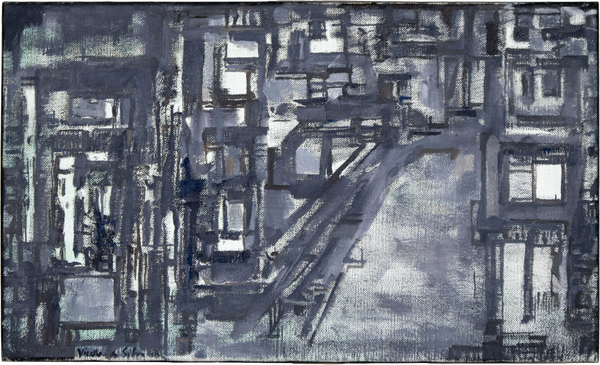Maria Helena Vieira Da Silva
Maria Helena Vieira da Silva, born in Lisbon, Portugal, in 1908, was a prominent figure in 20th-century abstract art. Renowned for her intricate, labyrinthine compositions and unique exploration of space and form, Vieira da Silva's work stands out for its blend of geometric precision and emotive depth. She began her artistic education in Lisbon, studying drawing and painting, before moving to Paris in 1928, where she immersed herself in the vibrant artistic scene and studied under influential figures such as Fernand Léger and Roger Bissière.
Vieira da Silva’s paintings are characterised by dense networks of lines and shapes that create complex, almost architectural spaces. Her use of muted tones and subtle colour gradations contributes to the illusion of depth and movement within the static medium of painting. This distinctive style, often compared to a visual form of poetry, emerged fully in the late 1930s and continued to evolve throughout her career.
During World War II, Vieira da Silva and her husband, Hungarian painter Árpád Szenes, fled to Brazil, where they remained until the war's end. This period in South America significantly influenced her work, infusing it with new cultural and visual elements. Upon returning to Paris in 1947, Vieira da Silva continued to develop her artistic practice, gaining recognition and acclaim.
In the 1950s and 1960s, Vieira da Silva's work was celebrated in major exhibitions worldwide, establishing her as a leading figure in the abstract art movement. Her paintings were included in prestigious institutions such as the Museum of Modern Art in New York, the Tate Gallery in London, and the Centre Pompidou in Paris. Notable exhibitions included her solo show at the Galerie Jeanne Bucher in Paris in 1951 and her participation in the Venice Biennale in 1958.
Vieira da Silva's contributions to art were recognised with numerous awards, including the French Legion of Honour and the Grand Prix National des Arts in France. She was also the first woman to receive the Grand Prix des Arts de la Ville de Paris, underscoring her significant impact on the art world.
Her work is often interpreted as a reflection on the complexity of modern life, with its intricate compositions suggesting maps, cityscapes, and networks. Despite the abstract nature of her work, Vieira da Silva's paintings evoke a sense of place and memory, resonating with viewers on a deeply emotional level.
In addition to her painting, Vieira da Silva was also involved in printmaking, tapestry design, and illustration, showcasing her versatility as an artist. Her creative legacy extends beyond her own work, influencing numerous artists and contributing to the broader understanding of abstract art.
Maria Helena Vieira da Silva passed away in 1992, leaving behind a profound legacy that continues to inspire and captivate. Her ability to blend geometric rigor with lyrical expressiveness ensures her place as a central figure in the history of abstract art. Her work remains a testament to her innovative vision and her enduring influence on contemporary art.
Featured Artists
- Ancart Harold
- Andre Carl
- Avery Milton
- Baldessari John
- Barnes Ernie
- Brice Lisa
- Castellani Enrico
- Crawford Brett
- Dadamaino
- Dávila Jose
- de Tollenaere Saskia
- Downing Thomas
- Dyson Julian
- Elsner Slawomir
- Freud Lucian
- Gadsby Eric
- Gander Ryan
- Guston Philip
- Haring Keith
- Held Al
- Hockney David
- Katz Alex
- Kentridge William
- Knifer Julije
- Le Parc Julio
- Leciejewski Edgar
- Léger Fernand
- Levine Chris
- LeWitt Sol
- Marchéllo
- Mavignier Almir da Silva
- Miller Harland
- Modé João
- Morellet François
- Nadelman Elie
- Nesbitt Lowell Blair
- O'Donoghue Hughie
- Odita Odili Donald
- Perry Grayson
- Picasso Pablo
- Pickstone Sarah
- Prehistoric Objects
- Quinn Marc
- Riley Bridget
- Ruscha Ed
- Serra Richard
- Shrigley David
- Smith Anj
- Smith Richard
- Soto Jesús Rafael
- Soulages Pierre
- Spencer Stanley
- Taller Popular de Serigrafía
- The Connor Brothers
- Turk Gavin
- Vasarely Victor
- Wood Jonas

